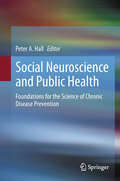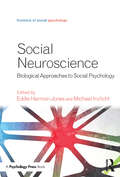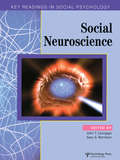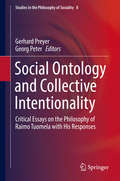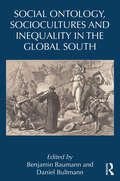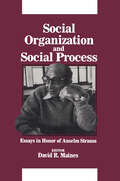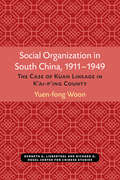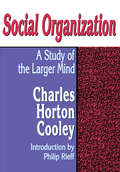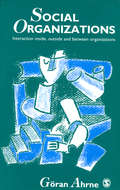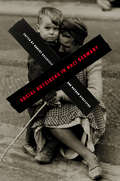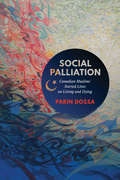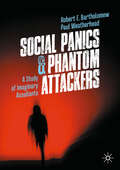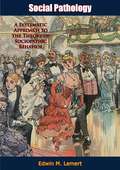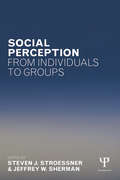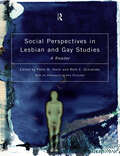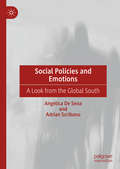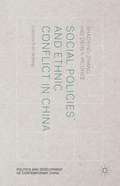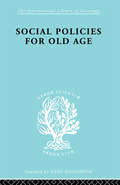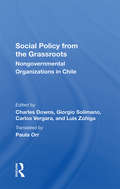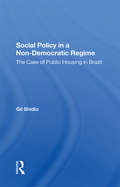- Table View
- List View
Social Neuroscience and Public Health: Foundations for the Science of Chronic Disease Prevention
by Peter A. HallThe field of public health is primarily concerned with understanding and improving physical health from a large group perspective (i.e., communities and whole populations). The field of social neuroscience, on the other hand, is primarily concerned with examining brain-behavior relationships that unfold in a social context. Both of these are rapidly developing fields of inquiry, and their boundaries have only recently begun to overlap. This book discusses collaborative research findings at the intersection of social neuroscience and public health that promise to fundamentally change the way scientists, public health practitioners, and the general public view physical health within the larger social context. Eighteen chapters are organized under the following major sections: cognition and health outcomes; neuroscientific aspects of health communication; health behavior and the neurobiology of self-regulation; neurobiological processes in health decision making; ecological and social context; neuroscience methods; and future directions.
Social Neuroscience: Biological Approaches to Social Psychology (Frontiers of Social Psychology)
by Eddie Harmon-Jones and Michael InzlichtSocial Neuroscience provides an updated and critically important survey of contemporary social neuroscience research. In response to recent advances in the field, this book speaks to the various ways that basic biological functions shape and underlie social behavior. The book also shows how an understanding of neuroscience, physiology, genetics, and endocrinology can foster a fuller, more consilient understanding of social behavior and of the person. These collected chapters cover traditional and contemporary social psychology topics that have received conceptual and empirical attention from social neuroscience approaches. While the focus of the chapters is demonstrating how social neuroscience methods contribute to understanding social psychological topics, they also cover a wide range of social neuroscience methods, including hormones, functional magnetic resonance imaging, electroencephalography, event-related brain potentials, cardiovascular responses, and genetics.
Social Neuroscience: Key Readings (Key Readings in Social Psychology)
by John T. Cacioppo Gary G. BerntsonNeuroscientists and cognitive scientists have collaborated for more than a decade with the common goal of understanding how the mind works. These collaborations have helped unravel puzzles of the mind including aspects of perception, imagery, attention and memory. Many aspects of the mind, however, require a more comprehensive approach to reveal the mystery of mind-brain connections. Attraction, altruism, speech recognition, affiliation, attachment, attitudes, identification, kin recognition, cooperation, competition, empathy, sexuality, communication, dominance, persuasion, obedience, morality, contagion, nurturance, violence, and person memory are just a few. Through classic and contemporary articles and reviews, Social Neuroscience illustrates the complementary nature of social, cognitive, and biological levels of analysis and how research integrating these levels can foster more comprehensive theories of the mechanisms underlying complex behaviour and the mind.
Social Ontology and Collective Intentionality
by Gerhard Preyer Georg PeterThis volume features a critical evaluation of the recent work of the philosopher, Prof. Raimo Tuomela and it also offers it offers new approaches to the collectivism-versus-individualism debate. It specifically looks at Tuomela's book Social Ontology and its accounts of collective intentionality and related topics. The book contains eight essays written by expert contributors that present different perspectives on Tuomela's investigation into the philosophy of sociality, social ontology, theory of action, and (philosophical) decision and game theory. In addition, Tuomela himself gives a comprehensive response to each essay and defends his theory in terms of the new arguments presented here. Overall, readers will gain a deeper insight into group reasoning and the "we-mode" approach, which is used to account for collective intention and action, cooperation, group attitudes, social practices, and institutions as well as group solidarity. This book will be of interest to a wide range of readers and graduate students and researchers interested in contemporary philosophy of sociality, sociological theory, social ontology as well as the philosophy of mind, decision and game theory, and cognitive science. Tuomela's book stands as a model of excellence in social ontology, an especially intractable field of philosophical inquiry that benefits conspicuously from the devotion of Tuomela's keen philosophical mind. His book is must reading in social ontology. J. Angelo Corlett, Julia Lyons Strobel
Social Ontology, Sociocultures, and Inequality in the Global South (Routledge Studies in Emerging Societies)
by Daniel Bultmann Benjamin BaumannChallenging the assumption that the capitalist transformation includes a radical break with the past, this edited volume traces how historically older forms of social inequality are transformed but persist in the present to shape the social structure of contemporary societies in the global South. Each social collective comprises an interpretation of itself – including the meaning of life, the concept of a human person, and the notion of a collective. This volume studies the interpretation that various social collectives have of themselves. This interpretation is referred to as social ontology. All chapters of the edited volume focus on the relation between social ontology and structures of inequality. They argue that each society comprises several historical layers of social ontology that correspond to layers of inequality, which are referred to as sociocultures. Thereby, the volume explains why and how structures of inequality differ between contemporary collectives in the global South, even though all of them seem to have similar structures, institutions, and economies. The volume is aimed at academics, students and the interested public looking for a novel theorization of social inequality pertaining to social collectives in the global South.
Social Organization and Social Process
by David MainesThe essays gathered in this volume contain analyses based on the general action perspective of Chicago sociology and, in particular, on the contributions of Anselm L. Strauss, whose lengthy achievement this volume honors.
Social Organization in South China, 1911–1949: The Case of Kuan Lineage in K’ai-p’ing County (Michigan Monographs In Chinese Studies #48)
by Yuen-Fong WoonBridging the collapse of the Confucian state and the establishment of the People’s Republic of China, the period 1911–49 is particularly fascinating to historians, anthropologists, sociologists and political scientists. Unfortunately, it is also a very confusing period, full of shifts and changes in economic, social, and political organizations. The social implications of these changes, and the relationships between officials on the subdistrict level, the unofficial leaders, and the bulk of the peasantry remain inadequately known. South China, which nurtured the Communist Party in its formative years, is a particularly interesting case. In this study I use the Kuan lineage of K’ai-p’ing as a case study to show the effects of demographic, economic, administrative, and educational changes after the Treaty of Nanking (1842) on patrilineal kinship as a principle of social organization in South China. [vii]
Social Organization of Medical Work
by Seymour LipsetToday we face the painful reality of the prevalence of chronic, rather than acute, diseases. The technologies developed to manager long-term, incurable illnesses have radically and irrevocably altered the organizational structure of health care, presenting us with a frequently bewildering array of medical specialties. Social Organization of Medical Work offers essential insight into this new era of health care.Through richly documented, often gripping case studies, Anselm Strauss and his co-authors show us exactly how health workers are confronting the problems created by chronic disease and coping with today's highly technologized hospitals. They guide us through the various hospital work sites, describing in detail the kinds of tasks performed by medical personnel, the interactions of staff members with each other and with patients, and the overall resulting patient treatment and response.Focusing on the concept of illness trajectory, the authors vividly illustrate the complex, contingent nature of modern medical work. For example, open heart surgery keeps ill persons alive and may even improve them symptomatically, but those who do survive must face an uncertain future in terms of the physiological consequences of the surgery and the drugs required. They also have to adjust t altered lifestyles. In the new introduction, Anselm Strauss discusses the continuing importance of this work to sociologists, medical scholars, and medical professionals.
Social Organization: A Study of the Larger Mind
by Charles Horton CooleyThis classic text has set a standard for American sociol-ogy. Cooley provides analysis without empiricism, applying psychological insight to his study of the individual and collective self. First published in 1909, this work attempts to motivate man and society to be more responsible to each other.""The style of his book is clear and attractive, the text abounding in happy quotation.""--Annals of the American Academy of Political and Social Science
Social Organizations and the Authoritarian State in China
by Timothy HildebrandtReceived wisdom suggests that social organizations (such as non-government organizations, NGOs) have the power to upend the political status quo. However, in many authoritarian contexts, such as China, NGO emergence has not resulted in this expected regime change. In this book, Timothy Hildebrandt shows how NGOs adapt to the changing interests of central and local governments, working in service of the state to address social problems. In doing so, the nature of NGO emergence in China effectively strengthens the state, rather than weakens it. This book offers a groundbreaking comparative analysis of Chinese social organizations across the country in three different issue areas: environmental protection, HIV/AIDS prevention, and gay and lesbian rights. It suggests a new way of thinking about state-society relations in authoritarian countries, one that is distinctly co-dependent in nature: governments require the assistance of NGOs to govern while NGOs need governments to extend political, economic, and personal opportunities to exist.
Social Organizations: Interaction Inside, Outside and Between Organizations
by Professor Goran AhrneIn this lively and wide-ranging essay, Göran Ahrne sketches an organizational theory of society. Combining the insights of organization theory with the traditional concerns of social theory, he makes an innovative and creative contribution to both fields. Using a broad definition of organizations, the author shows that what goes on inside, outside and among organizations is central to understanding social relations. Organizations provide people with resources and motives, and they set the frames for human action. Although organizations do not form societies or systems, society is shaped and changed through interaction between organizations. Drawing on various schools of organization theory, including institutional, ecological and contingency theories, the book shows how their synthesis with social theory clarifies the nature and effects of organizational interactions.
Social Origins of Educational Systems (Classical Texts in Critical Realism (Routledge Critical Realism))
by Margaret S. ArcherFirst published in 1979, this now classic text presents a major study of the development of educational systems, focusing in detail on those of England, Denmark, France, and Russia - chosen because of their present educational differences and the historical diversity of their cultures and social structures. Professor Archer goes on to provide a theoretical framework which accounts for the major characteristics of national education and the principal changes that such systems have undergone. Now with a new introduction, Social Origins of Educational Systems is vital reading for all those interested in the sociology of education. Previously published reviews: 'A large-scale masterly study, this book is the most important contribution to the sociology of education since the second world war as well as being a substantial contribution to the consolidation of sociology itself.' - The Economist 'I cannot improve on her own statement of what she is trying to do: 'The sociological contribution consists in providing a theoretical account of macroscopic patterns of change in terms of the structural and cultural factors which produce and sustain them'...Unquestionably, this book is an impressive work of scholarship, well planned conceptually and uniting its theoretical base with a set of four thoroughly and interestingly researched case-studies of the history of the educational systems of Denmark, England, France and Russia.' - British Journal of the Sociology of Education 'This magnificent treatise seriously explores many of the most recalcitrant questions about institutional systems.' - Journal of Curriculum Studies 'A gargantuan and impressive socio-historical enterprise.' - Encounter '...a major achievement.' - New Society
Social Outsiders in Nazi Germany
by Robert Gellately Nathan StoltzfusThey quickly took steps against those whom they wanted to isolate, deport, or destroy. In these essays informed by the latest research, leading scholars offer rich histories of the people branded as "social outsiders" in Nazi Germany: Communists, Jews, "Gypsies," foreign workers, prostitutes, criminals, homosexuals, and the homeless, unemployed, and chronically ill.
Social Palliation: Canadian Muslims’ Storied Lives on Living and Dying (G - Reference,information And Interdisciplinary Subjects Ser.)
by Parin DossaSocial Palliation is a pioneering study on living and dying as articulated by first-generation Iranian and Ismaili Muslim communities in Canada. Using ethnographic narratives, Parin Dossa makes a case for a paradigm shift from palliative care to social palliation. Experiences of displacement and resettlement reveal that life and death must be understood as an integrated unit if we are to appreciate what it is like to be awakened to our human existence. In the wake of structural exclusion and systemic suffering, social palliation brings to light displaced persons’ endeavours to restore the integrity of life and death. Dossa highlights the point that death conjoined with life is embedded within the socio-cultural and spiritual experience. Here, a caring society is not perceived in fragments, as is the case with traditional institutional care or care offered during end-of-life. Rather, Dossa draws attention to an organic form of caring, illustrated through the trajectories of storied lives. In exemplifying more humane aspects of social palliation, this book foregrounds sacred traditions to illustrate their potential to evoke deep-level conversations across socio-political boundaries on what it is like to live and die in the contemporary world.
Social Panics & Phantom Attackers: A Study of Imaginary Assailants
by Robert E. Bartholomew Paul WeatherheadThis book provides an accessible overview of one particular type of social panic: that of the phantom attacker. Such panics are characterised by outbreaks of sensational claims of attacks by mysterious figures that seem to emerge from nowhere, attack their innocent human and animal victims, only to vanish without a trace. Taking the recent wave of needle-spiking reports in Europe as a starting point, this book does more than just catalogue such outbreaks historically and geographically. It also ties the phenomenon of phantom assailants to the moral panics literature. Meticulously investigating archival sources, the authors examine the social construction of social panics and unearth the parallels between contemporary episodes and historical antecedents in Europe, North America, Asia and Africa. Focusing on the sociohistorical and -cultural context, they uncover the role of mass media in creating and perpetuating these panics, which respond to anxieties pervading societies at particular points in history. Written in a lively style, this book is not only of interest for scholars and students of sociology, criminology, social psychology, media studies and history but also appeals to a lay audience interested in urban legends and true crime.
Social Pathology: A Systematic Approach to the Theory of Sociopathic Behavior
by Edwin M. LemertPersons and groups are differentiated in various ways, some of which result in social penalties, rejection, and segregation. These penalties condition the form which the differentiation or deviation takes. Sociopathic differentiation and sociopathic individuation are theoretically considered and applications made to several groups of deviants: the blind, speech defectives, radicals, prostitutes, criminals, alcoholics, and psychotics.—APA
Social Pedagogy and Working with Children and Young People
by Claire Cameron Peter MossSocial pedagogy is an innovative discipline that supports children's upbringing and overall development by focusing on the child as a whole person. It has been described as where education and care meet or as 'education in its broadest sense'. This book provides a comprehensive overview of the theory, principles and practice of social pedagogy and the profession of social pedagogue. With chapters from leading international contributors, it outlines the roots of social pedagogy and its development in Europe, and its role in relation to individuals, groups, communities and societies. Also covered is how it applies in practice to working with children and young people in a variety of settings, including children in care and in need of family support, and its potential future applications. This seminal book on an increasingly important topic will be essential reading for all academics, researchers and practitioners working with children.
Social Perception from Individuals to Groups
by Jeffrey W. Sherman Steven J. StroessnerThis volume focuses on social perception, the processing of information about people. This issue has always been central to social psychology, but this book brings together literatures that in large part have been separated by the nature of the social target that is involved. Historically, research on person perception developed quite independently from research involving perceptions of groups. Whereas the former research generally focused on the cognitive processes involved in forming impressions of individuals, research on group perception examined the content of stereotypes and the conditions under which they are used in social judgment. There was been little overlap in the theories and methods of these subfields, and different researchers were central in each. The chapters in this book highlight research and theorizing about social perception, exploring the processes involved in social perception from persons to groups. Some chapters describe work that was originally developed in person perception but is being extended to understanding groups. Other chapters illustrate how some processes studied in the domain of stereotyping also affect perceptions of individual persons. Finally, other chapters focus on variables that affect perceptions and judgments of both individuals and groups, proving opportunities for greater recognition of the common set of factors that are central to all types of social perception. This groundbreaking book highlights the research contributions of David L. Hamilton, whose research has played a central role in uniting these previously independent areas of research. It provides essential reading for upper-level courses on social cognition or social perception and could also serve as an auxiliary text in courses on interpersonal perception/relations and courses on stereotyping/intergroup relations.
Social Perspectives in Lesbian and Gay Studies: A Reader
by Peter M. Nardi Beth E. SchneiderThis comprehensive reader brings a social science perspective to an area hitherto dominated by the humanities. Through it, students will be able to follow the story of how sociology has come to engage with gay and lesbian issues from the 1950s to the present, from the earliest research on the underground worlds of gay men to the emergence of queer theory in the 1990s. Bringing together classic readings and the best work of younger scholars from all parts of the English-speaking world, this reader will be an invaluable resource for courses at undergraduate and graduate level in all areas of the sociology of sexuality and gender. Separate sections cover: * theoretical foundations * identity and community making * institutions and social change * challenges for the future. Each section begins with an introduction giving readers a brief guide to the readings in that section, contextualises them and relates them to one another and the book ends with an afterword by Ken Plummer summing up the present state of play and looking forward to the future.
Social Philosophy (Routledge Library Editions: Social Theory)
by Hans FinkThe programmes of political parties and movements are attempts to formulate policies or guidelines in relation to social change. Social philosophy concerns the fundamental issues on which those programmes divide. This introductory work gives an account of several highly influential systems of social philosophy – systems which serve as the landmarks by reference to which modern discussions still orientate themselves. The description of various stages in the history of social philosophy is set within an account of its changing social environment – from feudalism and the philosophy of Aquinas to the rise of the working class and socialism. The book confines itself to the Western tradition and one could say that it charts the rise and fall of the free market as the central institution and the key to the understanding of society.
Social Policies and Emotions: A Look from the Global South
by Adrian Scribano Angélica De SenaThis book analyzes the connections between social policies and politics of sensibilities. The authors show how social policies build sociabilities, experiences and sensibilities, producing processes of conflict avoidance and consecration of the given. After discussing violence against women as a case study in order to understand the current state of social policies, the authors then describe how the “place” and “value” of education have become central features to social policies in order to disband conflict. Finally, they explain the emergence of a social phenomenon in the last sixteen years in Latin America and particularly Argentina: the compensatory consumption system and the resulting emergence of the “assisted citizen.”
Social Policies and Ethnic Conflict in China
by Derek Mcghee Shaoying ZhangThis study addresses how China's policy response to problems in Xinjiang is interpreted and implemented by officials, who are both governing agents and governed subjects by interviewing Chinese officials working in both Central government and Local governments.
Social Policies for Old Age: A Review of Social Provision for Old Age in Great Britain (International Library of Sociology)
by B. E. ShenfieldFirst Published in 1998. Routledge is an imprint of Taylor & Francis, an informa company.
Social Policy From The Grassroots: Nongovernmental Organizations In Chile
by Charles Downs Giorgio Solimano Carlos Vergara Luis ZunigaThe United Nations Children's Fund (UNICEF) has traditionally maintained very fruitful relationships with non-governmental organizations. The editors want to emphasize here is the significant role that these institutions play in designing and implementing programs to promote the development of children and women. This ·book is an analysis of non-go
Social Policy In A Non-democratic Regime: The Case Of Public Housing In Brazil
by Gil ShidloThis book had its origins in my doctoral research at the London School of Economics. It developed more rapidly than expected thanks to the good will and collective efforts of various people and institutions who provided help and support-material, intellectual and moralthroughout four years at the LSE and two years at Tel Aviv University. I am most grateful to George Philip and Patrick Dunleavy, who have patiently read the many drafts and offered their comments and suggestions at various stages of this work. I would also like to thank Peter Dawson, who during my early days at the LSE as a research and MSc student, supervised, advised and above all encouraged my intentions to carry out research on developing countries. Henrique Rattner of the Fundacao Getulio Vargas provided me not only with technical support but also introduced me to the complex Brazilian bureaucracy. Gabriel Bolaffi, of the Faculty of Architecture and Urbanism at the University of Sao Paulo, made it possible for me to gain access to the otherwise restricted public housing agencies. I also extend my gratitude to the officials at COHAB/SP, CODESPAULO, INOCOOP and the BNH (in Rio de Janeiro and Sao Paulo) who spared precious time to be interviewed and supplied me with published and unpublished documents. The IPT (Sao Paulo Institute of Technological Research) provided the primary material on ltaquera and enabled me to use their computing facilities and process the data. Special thanks are due to Ros Mari Kaupatez. The friends we made in Sao Paulo, whose welcome and warmth surpassed all expectations, made a long stay more bearable. This project could not have been carried out without the moral and financial support of both my grandfather and my parents, who took a deep interest in my studies and encouraged me during difficult periods. A debt of thanks is also owed to the Publication Committee of the London School of Economics, especially P. C. Davis. Anthony Hall's comments were very valuable. Thanks are due to the Faculty of Social Sciences and the Department of Political Science at Tel Aviv University for financial help in preparing this work for publication. Finally, this study is dedicated to my wife, Sarah, who interrupted her studies to accompany me to Brazil and helped me in ways I cannot adequately acknowledge.
